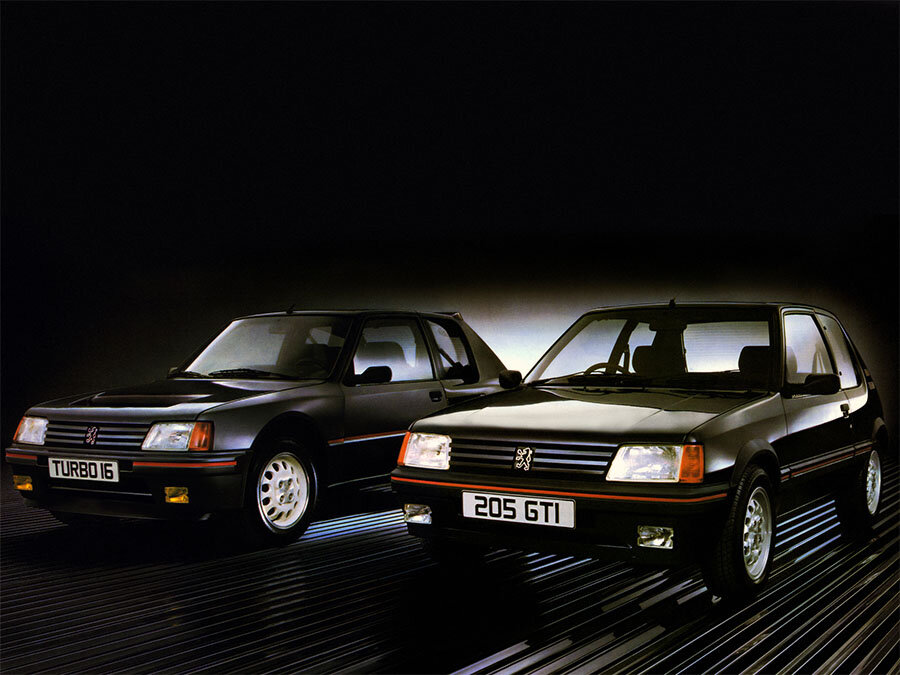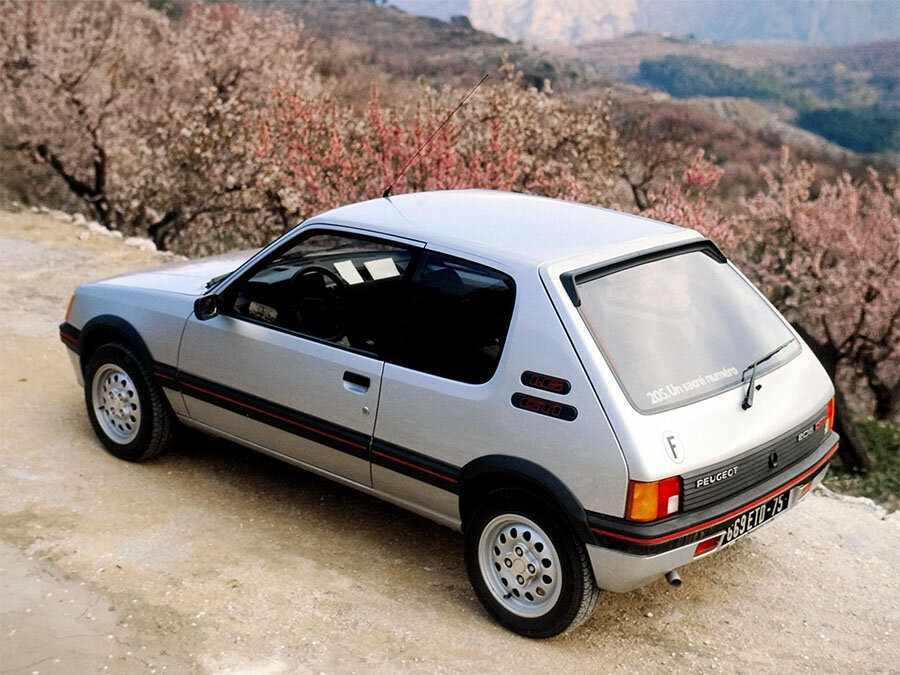Guide: Peugeot 205 GTi 1.6 - a Historical & Technical Appraisal
/BACKGROUND
By the early 1980s, Peugeot had acquired the image of a rather stuffy auto maker; their cars were technically conservative and visually unexciting.
Peugeot’s first foray into the Supermini segment was with the 104 in 1972. However, a sports version was never offered. Instead, for eleven years, Peugeot produced the 104 to serve as a utilitarian transport for the masses.
By contrast, Volkswagen’s Golf GTi had shown what could be done with a high performance Supermini.
When the critically acclaimed GTi was added to the Golf range in 1976, it sold by the bucketload. By 1983, Volkswagen had shifted 462,000 Golf GTis and established a new market segment for the Hot Hatch.
As an aspirational model, the Golf GTI also brought considerable prestige to the rest of the Volkswagen range and sales went up across the board.
In February 1983, Peugeot launched their replacement for the 104: the 205.
The 205 was styled in house by Gerald Welter (exterior) and Paul Bracq (interior). Pretty looks, fine driving dynamics, good build quality and competitive price saw the 205 become very popular.
Within a short space of time, it had turned Peugeot’s fortunes around.
Part of the 205’s appeal was its competition pedigree. A mid-engined Group B rally version had been shown in prototype form at the original 205’s February 1983 launch. The 205 T16 subsequently hit the track in May 1984 and picked up 16 WRC victories along with three championships.
To bridge the gap to the T16 road cars, 200 of which had to be made to secure Group B homologation, Peugeot decided to offer the 205 GTi.
Thanks to its punchy engine, improved handling and T16-inspired cosmetics, the 205 GTi was a revelation. It acquired the mantle as the definitive Hot Hatch of its era. Volkswagen gave up their crown as, in Mk2 trim, the Golf GTi gained size and weight.
Peugeot launched the 205 GTi in April 1984. It was never offered for sale in the USA and only came as a three-door Hatchback. A 1.6-litre engine was available from launch. A 1.9-litre GTi (covered separately) was added to the range in December 1986. The 1.9 ultimately stayed in production a little longer than the 1.6 owing to easier installation of a catalytic convertor.
CHASSIS
The 205 was based around a zinc galvanised steel bodyshell for which Peugeot offered a six-year anti-corrosion warranty. A 2420mm wheelbase and some smart design ensured there was adequate space for five adults in both three and five-door body styles.
Front-wheel drive was employed. For superior turn-in, track was 43mm wider at the front than the rear.
Suspension was independent all round. At the front were MacPherson struts, coil springs and lower wishbones. The back end used trailing arms fixed to a single beam, transverse torsion bars and telescopic shock absorbers.
For the GTi, Peugeot lowered the ride height, fitted stiffer shocks and springs and different wishbones. Anti-roll bars were added at either end.
The dual circuit brakes were servo-assisted. At the front, 247mm ventilated discs with a single-piston caliper were installed. Drums were fitted at the rear.
The GTi came with special 14-inch Speedline SL201 alloy wheels (also manufactured under licence by SMR). The rims were 5.5-inches wide all round and featured a distinctive twelve-hole Pepperpot design.
A 50-litre fuel tank was installed under the rear seat.
ENGINE / TRANSMISSION
Transversely mounted in the engine bay was a 1.6-litre Inline 4 complete with an aluminium alloy block and head. It featured water-cooling, a belt-driven single overhead camshaft, two valve cylinder head and wet-sump lubrication.
Peugeot originally offered the 205 with a choice of three petrol engines (1.0, 1.1 and 1.4) plus a diesel of 1.8-litres.
The GTi ushered a new top-of-the range 1.6-litre petrol engine: the XU5J 180A.
Whereas Peugeot’s 1.4-litre engine was configured with a bore and stroke of 75mm and 77mm respectively, the GTi engine was bored out to 83mm and ran a shorter 73mm stroke. Compression was upped from 9.3:1 to 9.8:1.
Bosch supplied new LE2-Jetronic multipoint fuel-injection.
Peak output was 105bhp at 6250rpm and 99lb-ft at 4000rpm. These figures represented a substantial gain compared to the 1.4-litre petrol unit which produced 75bhp at 6200rpm and 80lb-ft at 4000rpm.
Transmission was via Peugeot’s own close-ratio five-speed gearbox and a single dry plate clutch.
BODYWORK
Cosmetically, the 205 GTi was enhanced with a number of special body parts.
At the front, a deep new body coloured apron offered improved cooling and aerodynamics. Rectangular Siem spot lights were added in each corner. A custom rear apron was also created.
The standard 205’s dark grey plastic front and rear bumpers were accessorised with bright red inserts. Matching dark grey and red mouldings were added down each flank along with dark grey plastic wheelarch extensions.
Other special dark grey plastic body trim fitted to the GTi included special exterior mirrors, 1.6 and GTi-branded inserts on the C-pillars and a horizontally fluted panel between the tail lights.
At the top of the rear windscreen, Peugeot added a black rubber spoiler to complete the specification.
INTERIOR
Inside, the GTi came with a new instrument binnacle, a chunky two-spoke sports steering wheel embossed with the GTi logo, heavily bolstered front seats and special upholstery.
The rectangular instrument binnacle housed a large speedometer and rev counter flanked on the outside by smaller read outs for oil pressure, fuel level, water temperature and oil temperature. The entire dash assembly was formed in grey plastic.
The lever-type ventilation controls were located above the radio and below a bank of switches on the centre console.
Red carpet was used for the floor with red and dark grey fabric elsewhere.
Wind-up windows were standard.
Thanks to the slim cockpit pillars, all-round visibility was excellent.
OPTIONS
Optional extras were fairly limited. They included a sunroof, passenger-side exterior mirror, electric windows, rubber floor mats, an audio system and a choice of five exterior colours (Alpine White, Cherry Red, Graphite Grey, Silver and Black). Audio systems were frequently installed by the supplying dealer as were the likes of mud flaps. Another dealer fit option was a red reflective tail panel to replace the original fluted grey tailgate trim.
WEIGHT / PERFORMANCE
At just 850kg, the 205 GTi was a true featherweight. Top speed was 120mph and 0-62mph took 8.5 seconds.
Journalists and customers instantly fell in love with Peugeot’s little road rocket. Orders flooded in.
PRODUCTION CHANGES
A series of detail improvements were made to the GTi over the next ten years.
In February 1985, the suspension was softened to improve ride quality.
In May 1986, Peugeot introduced an updated XU5JA B6D engine that featured a redesigned big valve cylinder head with a new high performance camshaft. Peak output went from 105bhp to 115bhp at an unchanged 6250rpm. The torque rating of 99lb-ft at 4000rpm did not change.
A convertible 205 GTi, the CTi, was launched in June 1986. The 205 was masterfully converted into a convertible by Pininfarina; the roof folded completely back and stowed beneath a net cover. A black rollover bar improved safety and reduced chassis flex.
In August 1986, three rear seatbelts and dim / dip headlights were fitted as standard.
Peugeot added a 1.9-litre GTi to the range in December 1986. In addition to its bigger engine, the GTi 1.9 (covered separately) featured four-wheel disc brakes, further uprated suspension, half leather trim and electric windows as standard. Full leather was an optional extra.
In October 1987, a series of updates were made to both the 1.6 and 1.9-litre 205 GTis. Most significantly, the dash was subtly redesigned and a neat new central console panel was added. The centre console now featured rotary instead of sliding ventilation controls along with revamped switchgear. Externally, the original adhesive rear spoiler was changed to a simplified screw on type.
A new gearbox was phased in from August 1989. Reverse gear had originally been off to the left on its own but was now directly opposite fifth. A slightly bigger exhaust was added at the same time and the electric window switches now illuminated.
In October 1989, power steering was made an option.
Power steering was immediately bundled in as part of the Sorrento Green and Miami Blue special editions launched at the same time. These cars also came with a sliding sunroof, full grey leather, grey carpet and grey door cards. 600 were built of each variant with production split 50/50 between the 1.6 and 1.9-litre engine.
Also from October 1989, the 205 GTi could be specified in 1.9-litre trim with a catalytic converter. However, a cat was never fitted to the 1.6 variant.
Another major development arrived in September 1990 when anti-lock brakes were introduced as an option. Cosmetically, things were freshened up too: the bumpers, wheelarch extensions and side mouldings were made blacker, clear front indicators were added, the tail light clusters were redesigned and the reverse light was moved to the bumper.
Around the same time, Topaz Blue was temporarily added to the list of exterior colour options.
Laser Green Metallic was next to arrive in October 1990. Upon introduction, Laser Green Metallic could be ordered as part of the very high specification Griffe special edition that was available exclusively with the 1.9-litre engine.
As per Topaz Blue, Laser Green Metallic was offered for around twelve months.
In October 1991, air-conditioning was added to the options list. Remote central locking and a warning buzzer for the headlights became standard.
END OF PRODUCITON
Production of the 1.6-litre 205 GTi was discontinued on emissions grounds in September 1992.
The 1.9 continued in catalysed trim until April 1994 by which time a couple more special editions had rolled out of the factory.
In total, Peugeot built 61,653 GTis in 1.6 and 1.9-litre trim.
Text copyright: Supercar Nostalgia
Photo copyright: Peugeot - http://www.peugeot.com



































